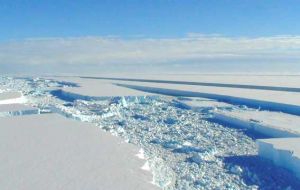MercoPress. South Atlantic News Agency
Antarctica's Wilkins Ice Shelf “hanging by a thread”

The continent of Antarctica is warming up in step with the rest of the world, according to a new analysis. Scientists say data from satellites and weather stations indicate a warming of about 0.6C over the last 50 years.
Writing in the journal Nature, they say the trend is "difficult to explain" without the effect of rising greenhouse gas levels in the atmosphere. Meanwhile, scientists in Antarctica say a major ice shelf is about to break away from the continent. The Wilkins Ice Shelf is said to be "hanging by a thread" from the Antarctic Peninsula, the strip of land pointing from the white continent towards the southern tip of South America. Most of Antarctica's scientific stations are located along the peninsula, and scientists have known for many years that this portion of the continent is getting warmer. But trends across the bulk of the continent have been much harder to discern, mainly because data from land stations is scarce. It is somewhat insulated from the rest of the world's weather systems by winds and ocean currents that circulate around the perimeter. In the new analysis, a team of US scientists combined data from land stations with satellite readings "We have at least 25 years of data from satellites, and satellites have the huge advantage that they can see the whole continent," said Eric Steig from the University of Washington in Seattle. "But the [land] stations have the advantage that they go back much further in time. "So we combined the two; and what we found, in a nutshell, is that there is warming across the whole continent, it's stronger in winter and spring but it is there in all seasons." They conclude that the eastern region of the continent, which is larger and colder than the western portion, is warming at 0.1C per decade, and the west at 0.17C per decade - faster than the global average. The 2007 assessment of the global climate by the Intergovernmental Panel on Climate Change (IPCC) concluded: "It is likely that there has been significant anthropogenic (human-induced) warming over the past 50 years averaged over each continent except Antarctica", with the word "likely" in this context meaning "at least 66% probability". The scientists said this study did not change that picture, with natural climatic cycles probably involved as well as elevated greenhouse gas concentrations. "It's hard to think of any situation where increased greenhouse gases would not lead to warming in Antarctica," said Drew Shindell from Nasa's Goddard Institute for Space Studies (Giss) in New York. "We're almost certain that greenhouse gas increases are contributing to this warming, but what's difficult is to attribute this warming and so say how much is down to natural warming and how much down to anthropogenic causes." Last year, scientists from the UK Met Office used climate models to attribute trends at the poles, and concluded that human emissions of greenhouse gases were largely responsible for the observed warming. Gareth Marshall from the British Antarctic Survey (BAS), who was not involved in the analysis, commented: "This study shows that, similar to the other six continents, Antarctica has undergone a significant warming over the past 50 years. "The magnitude of this warming is similar to the rest of the southern hemisphere, where we believe it is likely that human activity has played some role in the temperature increase, and therefore it is also likely that this is the case regarding an Antarctic warming." Over the last 30 years, satellites have also shown that sea ice is slowly growing in extent around Antarctica, which some observers say indicates a cooling across the continent or at least in the surrounding seas. But Walt Meier from the National Snow and Ice Data Center (NSIDC) in Boulder, Colorado, which follows ice trends at the poles, said wind patterns were probably the main reason. "Around Antarctica, the winds play a much bigger role than they do in the Arctic," he said. "If they're blowing northwards you can grow ice quite quickly and in contrast if they blow southwards the ice can contract quickly, whereas in the Arctic it's much more constrained (by land masses). "So this positive trend in the Antarctic is certainly not an indication of any cooling trend." One region that has seen spectacular losses of ice in recent years is the peninsula. A BAS team currently on site is reporting that the Wilkins shelf, about 15,000 sq km in area, is probably about to break free. "It really could go at any minute, and I wouldn't be at all surprised if the final cracks started to appear very soon," said BAS's David Vaughan. If it does, it will follow the course of other shelves that have made breakaways in recent years, such as the Larsen B in 2002. Although spectacular, such events are not necessarily due to man-made climate change. A much bigger question is whether the new analysis of Antarctic warming heralds any major melting in the West Antarctic ice sheet, which could lead to big changes in sea level and global impacts. "The vulnerability is higher than we thought, but still we face uncertainties in understanding these processes that make it very difficult to forecast when these changes would occur," said Drew Shindell.




Top Comments
Disclaimer & comment rulesCommenting for this story is now closed.
If you have a Facebook account, become a fan and comment on our Facebook Page!